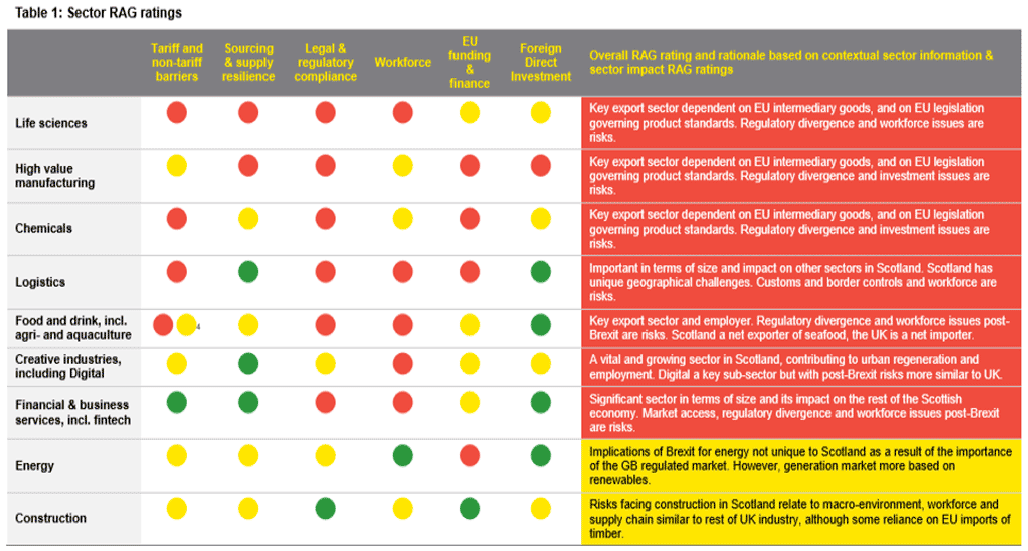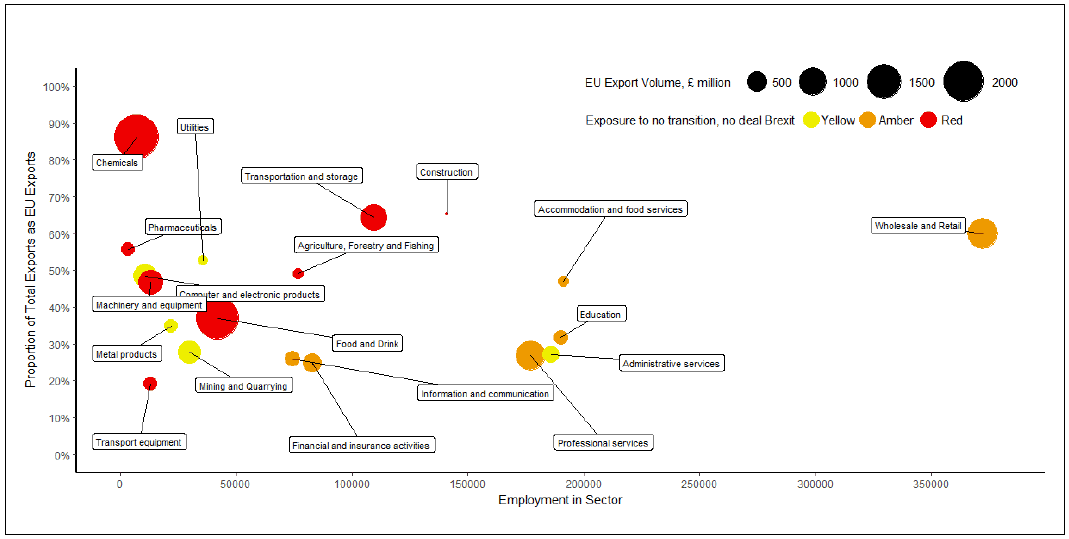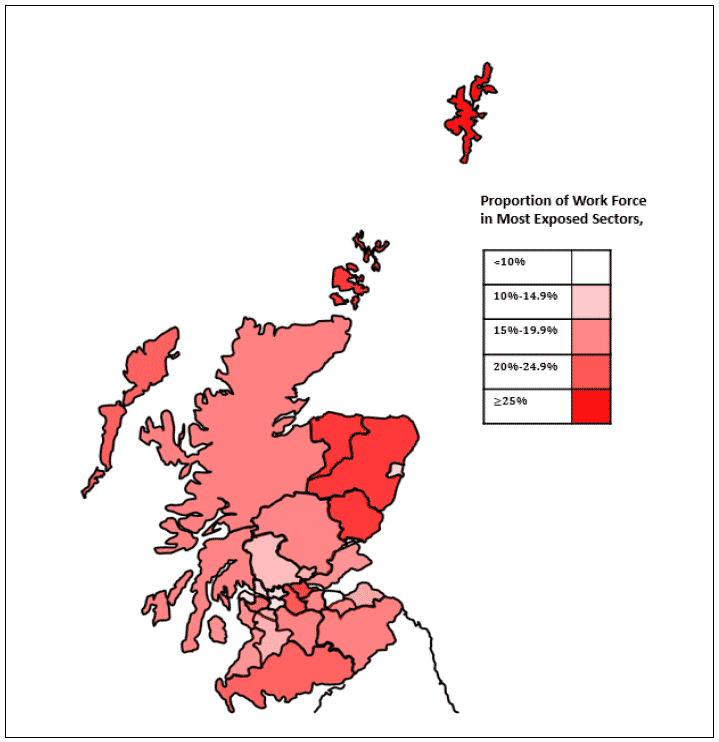No-deal Brexit: economic implications for Scotland
Illustration of the potential impact that a no-deal Brexit - leaving the EU on the 29th March 2019 without a transition period or agreement on any future trade deal and wider economic relationship - could have on the Scottish economy over the next 12-24 months.
Section 5 - Sector and Regional Impacts of No Deal Brexit
The impact of a No Deal economic shock will not be uniform across Scotland. Sectors which are likely to see the greatest impact will typically be those which:
- Trade the most with the EU;
- Are most reliant on EU workers and free movement of labour;
- Are dependent on, or feed in to, integrated EU supply chains;
- Are subject to EU regulatory and licencing requirements.
A prolonged slowdown would not be confined to sectors with direct exposure to the EU. It would impact other sectors through supply chain, employment and income effects. For example, if a No Deal Brexit leads to a fall in business investment this would have a significant impact on the construction sector.
The Scottish Government previously commissioned EY to undertake an analysis of the impact that an orderly Brexit could have on different sectors in the Scottish economy[22]. The results are summarised below.
Figure 22 - Sector Analysis

The Scottish Government has also undertaken its own modelling of the long term impact that Brexit could have on different sectors of the Scottish economy[23].
This modelling used a detailed two region model of the UK and Scottish economies to look at how sectors will be impacted as a direct result of Brexit, and also indirectly via the associated impact that Brexit will have in the rest of the UK. The modelling indicates that the Sectors that are likely to be most affected by Brexit are Chemicals; Mining and Quarrying; and Metals, Rubber & Plastic. This is reflective of these sectors having high trade exposure with EU markets. Although these sectors face the biggest proportionate impact, the impact on other sectors will be larger in absolute terms. The sectors that would see the largest overall impacts are in the service sector - Wholesale & Retail Trade, Professional Services, Financial Services and the Construction sectors.
Finally, the Bank of England has specifically considered the sectors which would be most at risk under a No Deal Brexit[24]. Their analysis suggests that Food and Agriculture, Chemicals and Pharmaceuticals, Transport and Construction could be most exposed under a No Deal Brexit.
Drawing on the above analysis, the chart below summarises the sectors which are likely to see the greatest exposure to a No Deal Brexit in 2019 under the scenarios considered in this paper. This suggests that Agriculture and Fishing, Transport Equipment, Chemicals, Pharmaceuticals, Food and Construction would see the greatest impact. However, all sectors would be negatively affected.
Figure 23 - Potential Impact of No Deal Brexit by Industry relative to overall decline in GDP
| Highest |
Higher |
In Line |
Below |
|---|---|---|---|
| Agriculture, Forestry and Fishing; |
Transport Equipment; |
Retail & Wholesale; |
Public Admin; |
The above analysis indicates which sectors could be most exposed to Brexit in relative terms. However, some of the sectors which appear to have less exposure to a No Deal Brexit are large in absolute terms (e.g. wholesale and retail). For such sectors even a small change in employment levels or economic activity can have a large impact in terms of Scotland's aggregate economic performance. This is highlighted in the chart below[25] which plots different sectors in terms of their overall employment, and the proportion of their exports going to the EU. The size of the bubbles represents the overall size of their exports to the EU, whilst the colour denotes a qualitative assessment of their exposure to a No Deal Brexit.
Figure 24 - Relationship between EU Exports and Employment

Regional Impacts of No Deal Brexit
A No Deal Brexit would have different impacts on different locations of Scotland, both in terms of the composition of the shock and its overall size.
In considering the overall impact that No Deal could have on different areas, a region's economic structure is a useful guide. The table and diagram below group local authorities in terms of their share of employment in sectors which are identified as being at high risk under a No Deal Brexit, as summarised above.
The local authorities with the highest concentration of workers in exposed sectors are typically those in more rural areas, reflecting higher levels of employment in agriculture and fishing in these areas.
Figure 25 - Proportion of Workforce in Brexit Exposed Sectors

Source: Scottish Government Analysis
Figure 26 - Local Authorities: Proportion of Workforce in Sectors Most Exposed to a No Deal Brexit
| <10% |
10% - 14% |
15% - 19% |
20% - 24% |
25%+ |
|---|---|---|---|---|
| Dundee |
Stirling |
Highland |
North Lanarkshire |
Shetland |
There are a range of other metrics which can be used to assess the areas of Scotland which could be most exposed to a No Deal Brexit. For example, the proportion of EU workers in a given locality. On this basis, 38,600 (28.2% of all EU nationals) reside in Edinburgh, 14,700 (10.7% of all) reside in Aberdeenshire, 14,300 (10.4% of all) reside in Glasgow, with these three cities accounting for around half of all EU nationals in employment in Scotland.
As a share of the workforce residing in an area, the areas with the highest levels of EU employment are Edinburgh (14.2% of all in employment in the area), Aberdeen (11.8%), Aberdeenshire (6.7%) Additionally, in rural agricultural areas, there will be high level of exposure and reliance on short-term seasonal employment of EU nationals.
Figure 27 - Employment by Local Authority by nationality
| Local Authority | EU 27 nationals | Employment | EU nationals share of LA employment | % of all EU nationals in employment |
|---|---|---|---|---|
| Edinburgh, City of | 38,600 | 272,000 | 14.2 | 28.2 |
| Aberdeen City | 14,700 | 123,800 | 11.8 | 10.7 |
| Glasgow City | 14,300 | 280,700 | 5.1 | 10.4 |
| Aberdeenshire | 9,400 | 138,900 | 6.7 | 6.8 |
| Highland | 6,800 | 122,300 | 5.5 | 5.0 |
| West Lothian | 5,700 | 88,500 | 6.4 | 4.2 |
Source: Annual Population Survey, July 2017 to June 2018
Contact
Email: OCEABusiness@gov.scot
There is a problem
Thanks for your feedback